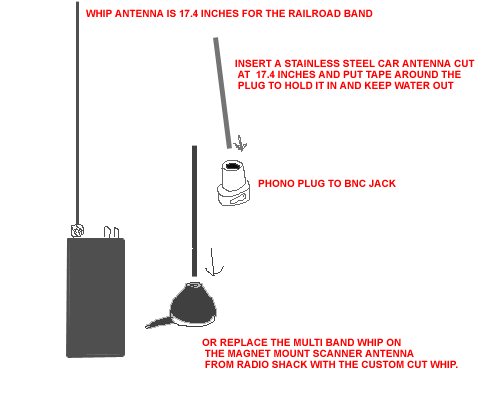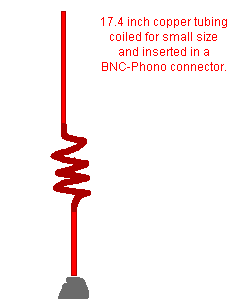RAILROAD RADIO SCANNING LISTENING
ANTENNAS · FREQUENCIES · RAIL RADIO ONLINE · LIVE RAILROAD RADIO · SCANNER TIPS FOR THE RAILFAN! · STRONG SIGNALS (SCANNER SITE) · RELM HS100 · NATIONAL ELECTRONICS · RUBBER DUCK ANTENNAS · SMILEY ANTENNA CO · AC6V AMATUER RADIO ENCYCLOPEDIA · AMATEUR ELECTRONICS SUPPLY · EHAM (AMATUER RADIO INFORMATION SITE)
Scanners come in handy while
train watching
because you can listen to the train crews talk to the dispatcher and
the maintenance of
way talking. You can also hear the "train defect detectors" or "hot box
detectors" talk to the trains. The detectors are equipment that detects
hot bearings
in the wheels, shifted loads, or dragging straps. The computers they
are hooked up to
transmit a computerized voice or recording over the road channel
frequency for that
railroad to let the train crews know if their train has a defect or not.
The
information here will be
similiar to other communications as well, so some info here might
be useful even if
you listen to something different than trains.
With these handheld antennas I have
made or bought(see
below) you can hear the locomotive radios 8-15 miles; hot box detectors
3-8 miles; the
dispatcher towers 20-30 miles; handheld radios called "packsets" are
1-3 miles.
These are for average weather conditions. Different times of the year
the reception is
different. These estimates are based on fall and spring and the copper
tubing whip antenna
on a handheld 30 channel Uniden Bearcat Scanner. With base
antennas the range will
be even farther than that depending on quality and type of coax, the
antenna used and the
height. On a mobile antenna the range will be about 5 miles
farther than a handheld
whip antenna while portable.
On certain radio towers there is a
repeater link for
the road channel of the line you are on. 452.900 is the repeater output
with both sides of
the conversations, and 457.900 is the input dispatcher only.
Corner reflector beam
antennas take the RR road ch off the simplex and goes to the repeater.
The repeater
is linked to the main tower with UHF Yagi beams. The repeater frequency
repeats everything
around 50 miles away!! Here at Emporia, Ks I can reach the BNSF radio
repeater (452.900)
at Olivet, Ks 30 miles away.
Another good thing to listen for is
the remote
controlled locomotives, (slave units) also called DPUs. I can hear them
10-15 miles away
with a good antenna and 30 miles on my ground plane antenna on the roof
about 55 feet
above ground. All you hear is computerized digital data that is
annoying but it won't let
you miss your train with DPUs on the rear!! Here at Emporia BNSF runs
one mixed freight
(H-KCKBAR Kansas City to Barstow), a doublestack (P-CHILAC Chicago to
Las Angelos), and a
grain train (symbol unknown), a day. Three out of 40-60 something
trains. Having my
scanner tuned to 457.925 makes finding those three a lot easier. UPRR
uses all four DP
frequencies on their coal trains: 452.925,452.95,457.925, 457.95.
I found KCS DPs on
457.95.
Remember the 400mhz is UHF so
having a good VHF/UHF
antenna is recommended. The handheld telescopic antenna from Radio
Shack is pretty good.
Make sure you read the instructions and figure the right length for
good performance for
the 160/452mhz range. At Strong
Signals.net
there are scanner and antenna reviews, which aid in buying a good
scanner and antenna for
your listening preferences.
The scanners I use are: Uniden
Bearcat 245XLT with 300
channels and trunktracking, and the RELM HS200. The HS200 is one of
the best Handhelds
selling right now that works good overall and for the railroad
scanning, except it isn't
as fancy as a Uniden or Radioshack, but a excellent performer.
But don't put it on
a base antenna in areas of strong transmitters, as it will overload.
The BC245xlt is
prone to intermod so it isn't recommended. The new Radio Shack
Pro95 scanner is
highly advanced and worth getting. Assuming it works as good as
the Pro92 and 93.
I also use my ham radios for railscanning as they are really
sensitive and don't get
interference quite as bad.
NOTE: THE PBX CHANNELS ARE LIKE MOBILE PHONES IN WHICH TRACK WORKERS AND SIGNAL MAINTAINERS CAN CALL THE DISPATCHER. YOU MIGHT WANT TO LOCK THESE CHANNELS OUT AND LISTEN TO THEM MANUALLY BECAUSE THEY ARE ACTIVE DURING THE WEEKDAYS AND YOU WILL MISS YOUR OTHER CHANNELS.
WHAT ANTENNAS WORK BEST
For portable use If you want a flexible whip antenna, there are some from 10-18 inches in length depending on model and they are made for the 144/440 ham frequencies and work fine for scanner bands too. The prices range from $20 to $50. I got a nice Comet CH75 dual band 144/440 and it works and looks nice, only $25.
www.aesham.com Amatuer Electronic Supply carries many handheld antennas, base antennas as well as receivers and amateur radios.
www.htantennas.com Smiley Antenna company is the best place I found, because the prices are cheap and you get commercial grade antennas tuned to the frequencies you need for optimum performance, such as 160 Mhz.
http://www.grove-ent.com/antennas.html Grove Enterprises has scanners, accessories and a variety of antennas, although some prices are high so check alternate suppliers.
For homemade stuff:
A whip antenna for the handheld, use a
stainless steel or
copper tubing whip antenna attached to a BNC to Phono jack works best
and can be cheaper
than most store bought antennas. The BNC to Phono jack adapter is about
$2 at Radio Shack.
The copper tubing at the hardware store I went to is $0.30 a foot. The
tubing is the
perfect size. It would help to paint it to make it stay clean and
polished and look nicer.
The stainless steal antenna is a car radio antenna for $4. It costs
more and is heavier
than the copper. The advantage of copper is it bends real easy and it's
lighter so it
won't be so hard on your antenna jacks. For the railroad band, the 1/4
wave antenna length
should be 17.4 inches long. If you don't like the color of copper or
get tired of
polishing it up, just paint it. The paint doesn't seem to harm the
reception.
Homemade base antennas: groundplane antennas, beams,etc see- SCANNER TIPS FOR THE RAILFAN!
For mobile use a scanner
magnet mount antenna from
Radio Shack for $29 and use a car antenna cut to length in place of the
other whip.
For the better quality, use the 5/8 wave Ham radio antenna, for $39 at
Radio Shack, with
four inches cut off the whip for the RR frequencies, is your best bet.
If you buy
name brand such as Larsen Antennas, Comet, or Diamond, they come with
cutting charts for
cutting the whip for the frequency desired.
For a Base station other
than a homemade groundplane
antenna, with more gain you can get a Grove Scanner Beam antenna that
covers the VHF-lo at
unity gain, VHF-hi 4-6db gain, UHF-lo band at 6-8db, and UHF-hi (800mhz
band) 10-12db
gain. You can buy a lightweight rotor to turn the antenna around
in different
directios, from Radio Shack or from TV antenna suppliers off the
internet for around
$70-$100. Also try Norm's rotor service http://www.rotorservice.com/.
That way
you can home in on you desired signal
plus nulling the signals from the back and sides.
Here's a formulas to figure out the antenna lengths:
Length of a 1/4-wave antenna [inches] = 2808 / frequency [MHz]

